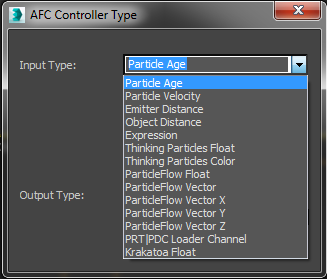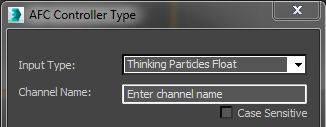Interpolation Controllers
Interpolation Controllers (ICs) enable you to vary the parameters by particle age (default PA controller), particle velocity, distance from the emitter, distance from any other object in the scene, or by using expressions. The easiest way to visualize how each controller works is to enable the "Show in Viewport" button in the Particle Source User Interface and to enable the "Radius" AFC.
In order to change between the various Interpolation Controller types, left-click the AFC Controller icon. You'll get the following dialog.

This dialog consists of Input Type list, parameters and Output Type list.
Input Type.
Particle Age (PA)
This is the default controller and it has no parameters. The AFC that uses this controller will interpolate between Low and High values based on the particle's age.
Particle Velocity (PV)
The Interpolation between Low and High values is based on the particle velocity. Interpolation is calculated using the AFC only if the particle velocity is in the Minimum to Maximum velocity range.
Emitter Distance (ED)
The interpolation between Low and High values is based on the particle distance from the particle system emitter. If the particle is further away than specified by the Maximum parameter, the interpolation will be done using AFC, but the High value will be applied. If the particle is closer than specified by Minimum, the Low values will be applied. All other distances ranging from Minimum to Maximum will be used to interpolate the parameter.
Object Distance (OD)
This Controller is similar to the Emitter Distance Controller, but instead of using a particle emitter as the only reference object, you can pick any object from the scene.
Expression (XE)
Using this controller, you can write your own expressions that will be used to interpolate between "Low" and "High" values using this AFC.
Thinking Particles Float (TF)
Any TP float data channel can be read.
You must enter a name for the data channel, since multiple particle groups in TP may have a channel with the same name and different ID. Search is case-insensitive by default.
The channel value can be used as an interpolation controller for the AFC or Gradient, but it can also replace Particle Source values completely if you check the "Replace values."
If the required data channel is not present or Particle Source has picked non-TP particles, it will default to the particle age.

Thinking Particles Color (TC)
Any TP color data channel can be read.
You must enter a name for the data channel, since multiple particle groups in TP may have a channel with the same name and different ID. Search is case-insensitive by default.
The channel value can be used only to Replace values of the Particle Source.
ParticleFlow Float (PF)
Uses the ParticleFlow float channel.
ParticleFlow Vector (PFv)
Uses the ParticleFlow vector channel.
ParticleFlow Vector - X Component (PFx)
Uses the ParticleFlow vector channel - x component.
ParticleFlow Vector - Y Component (PFy)
Uses the ParticleFlow vector channel - y component.
ParticleFlow Vector - Z Component (PFz)
Uses the ParticleFlow vector channel - z component.
PRT|PDC Loader Channel (PP)
FumeFX comes with the PRT|PDC particle system that allows user to read .prt and .pdc cache files and to access certain channels located inside those cache files.
Krakatoa Float (KF)
Allows access to a user defined channel from Krakatoa particle system.